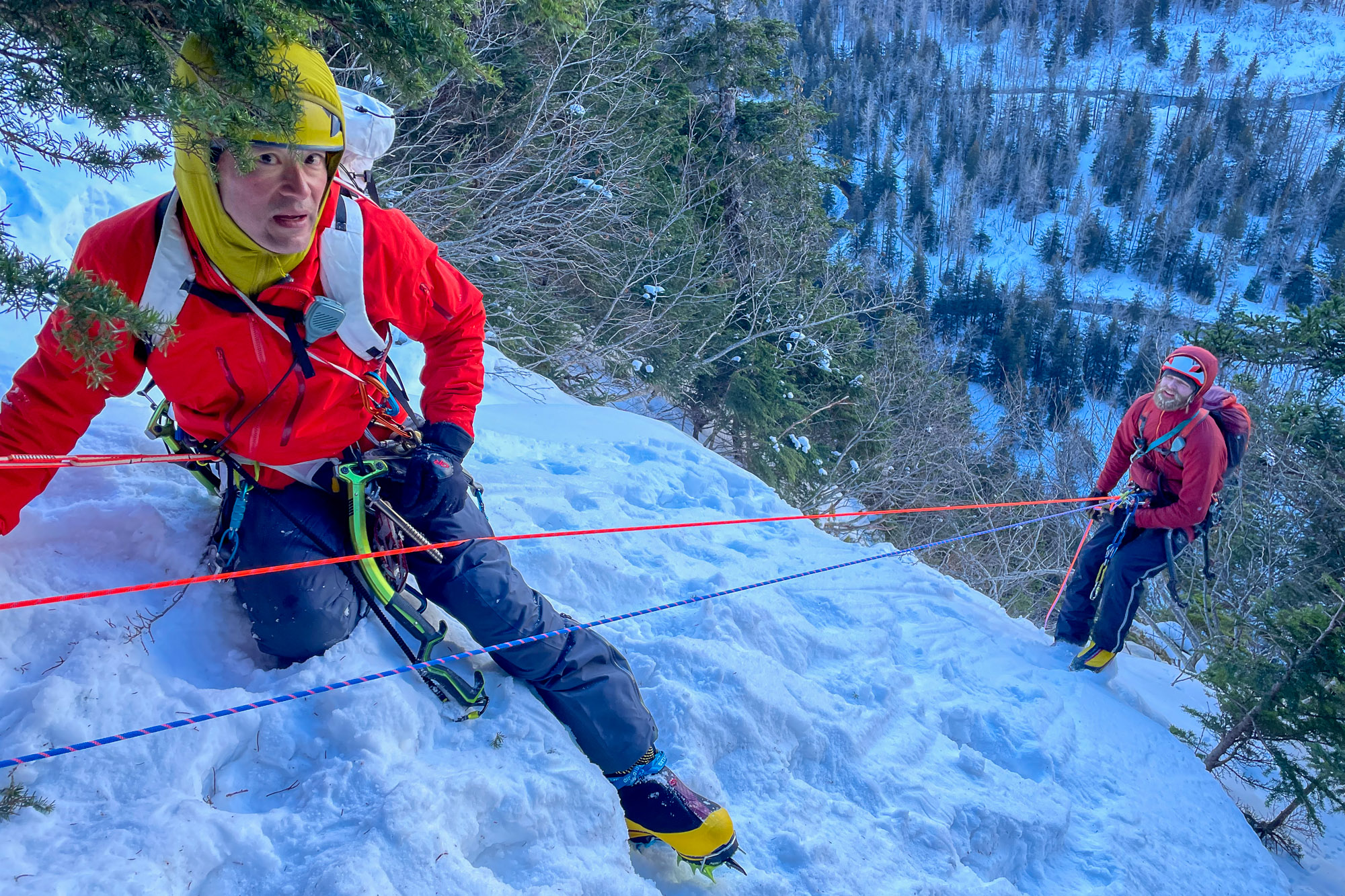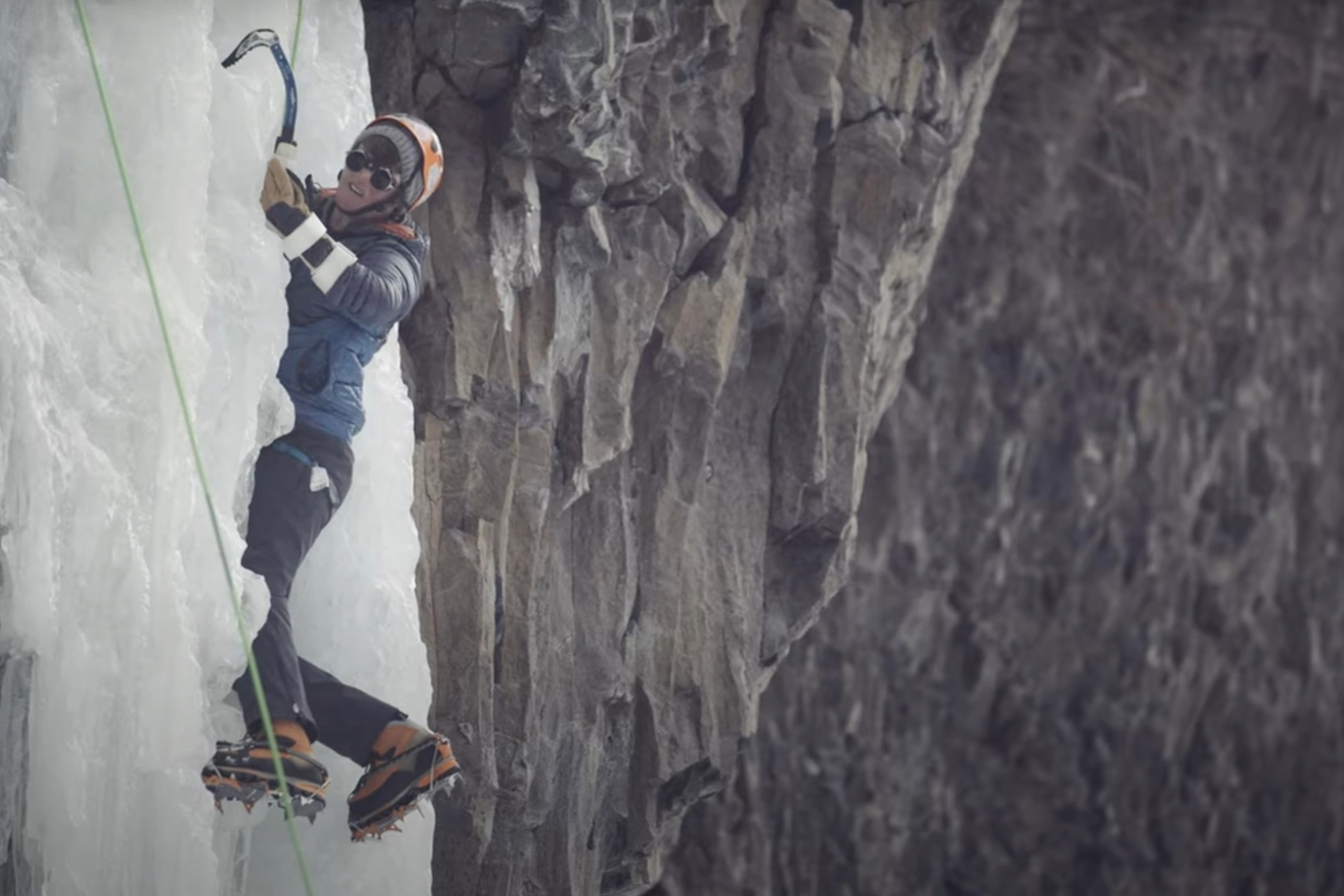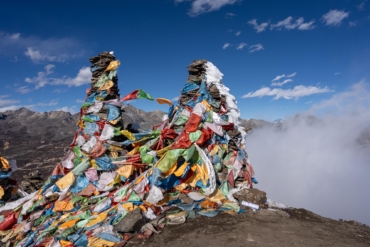I’ve been chasing frozen formations to climb for decades. I started making forays into the 49th state in the ’90s. Ropes were fat, and ice climbers tethered straight-shafted axes to their wrists. Since then, the gear used to scratch lines up the ephemeral routes has changed immensely. As the GearJunkie climbing editor, I’ve been fortunate enough to sample much of it.
Alaska is home to big, tall, multipitch routes I target on my yearly pilgrimage to the northernmost state. Some trips resulted in first ascents for my team. Others produced second ascents or success on rarely forming and climbed ice falls. On each trip, I’m armed with the newest gear. Some ice climbing gear was a definite improvement, while others were failures that sometimes produced stressful results.
Here’s my favorite ice climbing gear for big, backcountry routes. Hopefully, this list will be updated yearly as the gear undoubtedly changes, and my short memory keeps me returning to Alaska’s cold and rugged landscapes.
Ice Tools
Ice tools, along with crampons, are crucial to success on Alaska’s bounty of ice. They are the points of contact with the frozen medium of ice climbing.
Ice tools have morphed from shorter versions of glacier travel axes to highly specialized tools for ice and mixed climbing. Shafts used to be straight. Now, they come in all forms of permutations with ergonomic handles. Picks have concurrently changed and become specialized for ice and mixed routes. Finally, material advancements, like carbon fiber, have entered the ice-scaling game.
Favorite Ice Tool for Alaska: Trango Kestrel ($500 Each)

Over the last decade, I’ve schlepped two models of ice axes on each of my trips into the Alaskan backcountry, and this one tool stood above the rest. The Trango Kestrel possessed the right combination of total weight, head weight, pick effectiveness, and ergonomics, never leaving me wanting anything else.
At a verified 1 pound, 3 ounces per tool with the included 2.3-ounce head weights, the Kestrel was in the Goldilocks zone for big, backcountry ice. They were lighter than more aggressive, steel-shafted tools like the Black Diamond Reactor (1 pound, 6 ounces without head weights).
This saved precious energy on long, steep approaches and impossibly big formations. But they had more heft than superlight ice tools like the Grivel Dark Machine (17.2 ounces per tool without head weight). This made swings feel better and require less oomph for a solid stick, and the heads resisted rotating much better than lighter tools.
I found the shaft bend to save my knuckles from getting bashed, even on lower-angled ice, which has proven rare. I also preferred the identical feeling main grip and choke grip, which were perfectly sized for gloves usable in the 0-20-degree range. The gritty shaft texture also proved effective with winter gloves.
And, as a bonus, the carbon fiber/Kevlar shafts damped harsh vibrations from smashing the hardest, coldest ice, which saved my hands, arms, and wrists over long routes on consecutive days. The included ice picks also performed remarkably well on hard-water ice; that is, I never noticed them. They just worked.
The glaring downside is the price of the Trango Kestrel — $1,000 for a pair of ice tools adds to the financial burden of an already expensive endeavor. But, Trango offers a respite.
Honorable Mention Ice Tool: Trango Raptor ($190 Each)

Trango keeps Kestrel ergonomics, head, and pick but replaces the carbon/Kevlar shaft with aluminum, resulting in the Raptor. With all the similarities with the Kestrel, it’s no surprise that I loved the Raptor during my last ice-climbing foray in Alaska. They felt remarkably like the Kestrels. I noticed the different grip textures (the Raptor uses rubber) and vibration damping of the aluminum shafts.
However, the value proposition is difficult to argue at less than half the cost of the Kestrel. It’s one of the best deals on ice-climbing gear I’ve seen.
Favorite Crampons for Alaska Ice Climbing: Grivel G20 Plus ($250)

Next to ice tools, crampons are the most crucial ice-climbing gear for performance and safety. I have used so many crampons over the decades. From terrible versions that balled up snow to no avail to ones that didn’t allow secondary points ever to touch the ice, I’ve suffered more due to lousy crampon design than any other gear-related issue.
Crampons must fit boots well and remain secure. Popping a toe bail on lead makes for a harrowing experience. The front points must allow for a natural kick and a reassuring bite into the hardest ice.
They must also provide traction on snowy, icy, and rocky approaches. Finally, they must be super durable. Crampons suffer through so much abuse, and failure can be devastating.
I’ve liked a few crampon models, but I’ve only loved one: the Grivel G20 Plus. The front point configuration won me over. The G20 has a big toe-oriented monopoint and a smaller and shorter secondary “snaggletooth.” This configuration provided the best of both monopoint and double-point crampons.
I got the versatility, accuracy, and athleticism of a monopoint with the added stability and security of double points. I could delicately stab a slim chandelier or place the monopoint on the smallest feature. Sometimes, I used rock climbing shenanigans since I could rotate around that point. But I also felt more secure and used less energy to hold the points still on sketchy terrain with the snaggletooth engaged.
The steel Grivel uses on the G20 Plus also proved incredibly robust, thwarting all attempts to grind them down. I climbed entire weeks without ever taking a file to them, even though I felt I had abused them. And they have never suffered a failure of any part over multiple seasons.
The G20 Plus isn’t the lightest crampon that I’ve tested. At a verified 1 pound, 15 ounces per pair, there are lighter contenders. But again, I’ve never loved a crampon other than the Grivel G20 Plus.
Favorite Ice Climbing Boots: LaSportiva G2 EVO ($999 per Pair)

My primary focus for ice-climbing boots in Alaska is warmth. Arguing the nuances of performance didn’t make sense to me if I suffered frostbite. And no other boot has kept my feet and toes warmer than the LaSportiva G2 EVO.
On my last trip to Alaska, the climbing temperatures rarely exceeded the single digits, and with wind chill, they were often below zero. Long belays in snow or on icy ledges in these conditions have gotten my toes cold enough to go numb, sometimes painfully.
The metal crampons didn’t help as they sucked heat out of the boot as well. But not so with the La Sportiva G2 EVO. I never had my toes numb, and this past season was arguably the coldest I’ve experienced.
I dislike using the term “game changer,” but the dual BOA dials on the G2 proved to be just that in the realm of ice-climbing gear. The BOA dial on the inside of the gaiter cinched down on the ankle, while the one on the boot’s exterior did the same for the foot.
Adjusting these on the fly, even on route, was an advantage that cannot be overstated. I could keep them looser on approach, improving my comfort on skis or on foot. Then, I tightened them before climbing and often loosened the exterior dial at belays to improve vital blood circulation. A few turns tightened the boot down again to enhance climbing performance.
The boot is necessarily bulkier than others I’ve used, but none were as warm as the LaSportiva G2 EVO. And again, keeping my feet protected against cold injury was always the priority in Alaska.
Favorite Shell System: Arc’teryx Alpha SV Jacket ($900) and Alpha SV Bibs ($700)

I’ve destroyed shells in Alaska in as little as a single pitch. Ice climbing is notoriously hard on shells. From ice tool picks, crampon points, ice screws, rocks, and constant abrasion from climbing harnesses, even the most expensive, highly touted shell systems have succumbed to the hostile conditions in short order.
None have survived multiple seasons without at least some damage from other ice climbing gear or the environment. But the Arc’teryx Alpha SV Jacket and Bibs have only suffered a tiny puncture due to crampon-use error over a few seasons. This is incredible, as I have a closet full of shells with tears, delamination, large holes, and other damage from a single season.
On this past trip to Alaska, I unexpectedly fell on loose, unconsolidated snow on the approach to a route. I slid over rocks and through alder branches. I felt crampons catch on my bibs and rocks grating across my back. Luckily, I stopped my rapid descent by grabbing an alder branch.
A climbing partner rushed down to check on me. I was amazingly unharmed. Although a side zip on the bibs got dragged open, hilariously exposing my rear, the shell remained undamaged for the rest of the week.
The Arc’teryx Alpha SV has been a go-to shell for hardcore alpinists for a while now. The GORE-TEX PRO with Most Rugged Technology has withstood everything I’ve thrown at it and has reliably protected me from all of Alaska’s fury. It may not be the lightest shell in the game and is very expensive, but it’s the most robust, making it my number one choice for ice climbing in Alaska.
And as a bonus, in 2024, Arc’teryx updated the 100-denier face fabric. It is now made of 100% recycled content.
Favorite Harness: Edelrid Prisma Guide ($100)

Unlike rock climbing harnesses, the models I choose for alpine or ice can have less padding and structure. I’m usually in multiple layers of clothing, especially in Alaska, so I don’t need more cushion from the harness. I spend very little time hanging in a harness and almost never fall in it (knock on wood), so I can get away with less structure.
But what is important for big, multipitch ice routes in Alaska is climbing speed. Days are very short during the ice season at the extreme northern latitudes, and the weight of ice climbing gear is a critical factor. So “light is right” for getting up and down within the constricted time windows. But like all the gear on these missions, the harness still has to withstand jagged rock, ice screw teeth, ice axe picks, and sharp ice features.
The Edelrid Prisma Guide checked all the boxes for me. At 5 ounces for a medium, it’s definitely lightweight. The Dyneema and nylon construction gave it just enough shape to thread my bulky boots and crampons through the leg loops. And it withstood all the trashing a week’s worth of Alaskan vertical adventuring delivered without even so much as a nick.
Four rigid and two soft gear loops kept draws, runners, and other gear organized and at the ready. And four ice clipper attachment points ensured I could ferry as many ice screws as necessary.
Favorite Ice Screw: Petzl Laser Speed Light ($85)

Placing ice screws on lead is the most involved and time-consuming protection placement in climbing. And nothing stresses me out more than fumbling an ice screw. From false starts to that unnerving feeling that it’s too easy to spin the screw, I’ve spent more mental and emotional energy on a few ice screw placements than all other climbing protection placements in my life combined.
And unlike quickdraws or trad gear, the cost of ice screws means sharing them on almost every outing. So, over the decades, I’ve been able to sample nearly every available ice screw. For long, multipitch routes in Alaska, the Petzl Laser Speed Light is the ice screw of choice for the crew.
They start reliably, the threads have the just right resistance to turning, and the handle works well with gloves. They also have the feeling of quality that Petzl climbing gear has delivered for as long as I’ve been climbing. And they are reasonably light at 100 g for the 17cm length.
One caveat: In my experience, as well as other seasoned ice climbers, the aluminum threads can get “sticky” in wet ice compared to their steel-shafted counterparts (the Petzl Laser Speed). But this is a nick we’re willing to take for the lower weight, especially considering the dozen or more screws required on Alaskan routes.
Favorite Rope: Mammut 7.5 Alpine Sender Dry ($250 Each, 70m)

Climbing ropes have diminished in diameter over the decades, making for extremely light cords with minimal drag. Both of these attributes contribute to the speed of climbing long, wandering routes in the extremely short days of the Alaskan ice-climbing season.
At 7.5mm in diameter, each Mammut Alpine Sender Dry rope weighs a verified 6 pounds, 6 ounces in the 70 m length. This contributed to our minimalist approach to the ice climbing gear we elected to haul against gravity.
The dry treatment fared well. We never suffered from frozen cords, even when they were exposed to unavoidable drips during long belay sessions. The slick, dry treatment and small diameter also allowed the ropes to snake through gear easily in both the twin and double rope configurations.
None of these positives matter if the ropes aren’t durable. The Mammut 7.5 Alpine Sender Dry looked fresh after being dragged and rappelled down (three times) up thousands of feet of unrelenting ice and rock. We laid out our gear to dry after the final day, and it was remarkable that we didn’t see a single fuzzy spot or nick in the sheaths.
There were two negatives to using such thin and light cords, neither of them particular to the Mammut ropes. The first was the increased tendency to tangle when tossing the coiled rope down to set up rappels, especially in the wind. Great care had to be taken to manage the ropes in these situations. (I almost got stranded on the top of the same wall in 2018 when similarly sized cords became impossibly knotted.)
The other downside was the reduced amount of friction the ropes provided compared to larger-diameter models. This was especially poignant when wearing thick gloves over sometimes numb hands. A prussik or similar rappel backup was mandatory, and often, we had a Fireman’s belay going on at the same time. But again, this is the case with other sub-9mm ropes.








